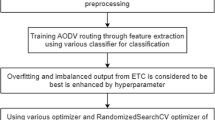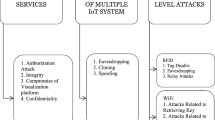Abstract
Mobile ad hoc network is a network type, where wireless network comprises independently moving nodes that cooperatively contribute towards making a network operate successfully. These nodes are tiny electronic devices operating on battery power and have limited operational resources, such as memory, buffer capacity and processing units. These nodes can act as client, server or router, depending upon the network requirement because of the absence of a centralized server control. MANET faces lots of challenges while maintaining a secured and resilient communication due to its limited resources and operational capacity. One of the serious challenges is handling and classifying tons of incoming data at a single point of time for efficient processing. As tons of data enter MANETs network at a single point of time, it is necessary to deploy a new mechanism not only for classification but also for further processing. The heavy and extensive data become unmanageable on the part of mobile nodes while implementing techniques like data analysis to trace anomaly or extracting the required information from the data pool incoming into MANETs. This unmanageable data calls for classification technique so as to segregate data into specific group that can be further utilized for implementing or formulating a specialized mechanism that tends to solve many other research problems. The objective of this paper is to classify the incoming data into MANETs and reduce the data set using the RF/ ET technique. The results showed that the proposed model attained an accuracy level of 86% in handling data packets in MANETs.
Access this chapter
Tax calculation will be finalised at checkout
Purchases are for personal use only
Similar content being viewed by others
References
Kaur, M., & Nayyar, A. (2013). A comprehensive review of mobile ad hoc networks (MANETS). International journal of emerging trends & technology in computer science (IJETTCS), 2(6).
Nayyar, A., & Singh, R. (2014). A comprehensive review of ant colony optimization (ACO) based energy-efficient routing protocols for wireless sensor networks. International Journal of Wireless Networks and Broadband Technologies (IJWNBT), 3(3), 33–55.
Nayyar, A., & Singh, R. (2017). Ant colony optimization (ACO) based routing protocols for wireless sensor networks (WSN): A survey. International Journal of Advanced Computer Science and Applications, 8, 148–155.
Nayyar, A., & Singh, R. (2016, March). Ant colony optimization—Computational swarm intelligence technique. In 2016 3rd International Conference on Computing for Sustainable Global Development (INDIACom) (pp. 1493–1499). IEEE.
Silipo, R., Adae, I., Hart, A., & Berthold, M. (2014). Seven techniques for dimensionality reduction. White Paper by KNIME. com AG, 1–21.
Pal, M., & Foody, G. M. (2010). Feature selection for classification of hyperspectral data by SVM. IEEE Transactions on Geoscience and Remote Sensing, 48(5), 2297–2307.
Marcano-Cedeño, A., Quintanilla-Domínguez, J., Cortina-Januchs, M. G., & Andina, D. (2010, November). Feature selection using sequential forward selection and classification applying artificial metaplasticity neural network. In IECON 2010-36th annual conference on IEEE industrial electronics society (pp. 2845–2850). IEEE.
Agrawal, S., & Agrawal, J. (2015). Survey on anomaly detection using data mining techniques. Procedia Computer Science, 60, 708–713.
Chang, Y. H., Gray, J. W., & Tomlin, C. J. (2014). Exact reconstruction of gene regulatory networks using compressive sensing. BMC Bioinformatics, 15(1), 400.
Chen, X., & Ishwaran, H. (2012). Random forests for genomic data analysis. Genomics, 99(6), 323–329.
McClary, D. W., Syrotiuk, V. R., & Lecuire, V. (2008). Adaptive audio streaming in mobile ad hoc networks using neural networks. Ad Hoc Networks, 6(4), 524–538.
Gite, P., & Thakur, S. (2015). An effective intrusion detection system for routing attacks in manet using machine learning technique. International Journal of Computer Applications, 113(9).
Michalski, R. S., Carbonell, J. G., & Mitchell, T. M. (Eds.). (2013). Machine learning: An artificial intelligence approach. Springer Science & Business Media, Berlin.
Dietterich, T. G. (2002, August). Machine learning for sequential data: A review. In Joint IAPR International Workshops on Statistical Techniques in Pattern Recognition (SPR) and Structural and Syntactic Pattern Recognition (SSPR) (pp. 15–30). Springer, Berlin, Heidelberg.
Author information
Authors and Affiliations
Corresponding author
Editor information
Editors and Affiliations
Rights and permissions
Copyright information
© 2020 Springer Nature Singapore Pte Ltd.
About this paper
Cite this paper
Nayyar, A., Mahapatra, B. (2020). Effective Classification and Handling of Incoming Data Packets in Mobile Ad Hoc Networks (MANETs) Using Random Forest Ensemble Technique (RF/ET). In: Sharma, N., Chakrabarti, A., Balas, V. (eds) Data Management, Analytics and Innovation. Advances in Intelligent Systems and Computing, vol 1016. Springer, Singapore. https://doi.org/10.1007/978-981-13-9364-8_31
Download citation
DOI: https://doi.org/10.1007/978-981-13-9364-8_31
Published:
Publisher Name: Springer, Singapore
Print ISBN: 978-981-13-9363-1
Online ISBN: 978-981-13-9364-8
eBook Packages: EngineeringEngineering (R0)




